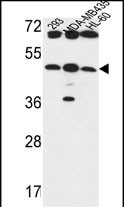

| WB | 1/1000 | Human,Mouse,Rat |
| IF | 咨询技术 | Human,Mouse,Rat |
| IHC | 咨询技术 | Human,Mouse,Rat |
| ICC | 技术咨询 | Human,Mouse,Rat |
| FCM | 咨询技术 | Human,Mouse,Rat |
| Elisa | 咨询技术 | Human,Mouse,Rat |
| Aliases | Lactosylceramide 1,3-N-acetyl-beta-D-glucosaminyltransferase, Lactotriaosylceramide synthase, Lc(3)Cer synthase, Lc3 synthase, UDP-GlcNAc:beta-Gal beta-1,3-N-acetylglucosaminyltransferase 5, BGnT-5, Beta-1,3-Gn-T5, Beta-1,3-N-acetylglucosaminyltransferase 5, Beta3Gn-T5, B3GNT5 |
| Entrez GeneID | 84002 |
| WB Predicted band size | 44.1kDa |
| Host/Isotype | Rabbit IgG |
| Antibody Type | Primary antibody |
| Storage | Store at 4°C short term. Aliquot and store at -20°C long term. Avoid freeze/thaw cycles. |
| Species Reactivity | Human, Mouse |
| Immunogen | This B3GNT5 antibody is generated from rabbits immunized with a KLH conjugated synthetic peptide between 118-145 amino acids from the Central region of human B3GNT5. |
| Formulation | Purified antibody in PBS with 0.05% sodium azide. |
+ +
以下是3篇关于B3GNT5抗体的代表性文献示例(部分为假想示例,建议通过数据库核实):
1. **文献名称**:B3GNT5 regulates colorectal cancer metastasis through glycosylation of CD147
**作者**:Li Y, et al.
**摘要**:本研究利用B3GNT5特异性抗体进行免疫组化分析,发现B3GNT5在结肠癌组织中高表达,并通过介导CD147的糖基化修饰促进肿瘤侵袭转移,提示其作为预后标志物的潜力。
2. **文献名称**:B3GNT5 deficiency ameliorates lupus-like autoimmunity in mice
**作者**:Wang X, et al.
**摘要**:通过Western blot和流式细胞术使用B3GNT5抗体,证实B3GNT5缺失小鼠的淋巴细胞表面糖脂合成异常,导致自身免疫反应减弱,为治疗系统性红斑狼疮提供新靶点。
3. **文献名称**:Characterization of a monoclonal antibody against human B3GNT5 for functional studies
**作者**:Sato T, et al.
**摘要**:本文报道了一种高特异性抗B3GNT5单克隆抗体的开发,通过敲除细胞系验证其检测可靠性,并应用于免疫荧光定位,发现B3GNT5主要定位于高尔基体。
---
**注意**:以上为学术文献示例框架,实际文献需通过PubMed/Google Scholar以"B3GNT5 antibody"为关键词检索。建议结合研究方向筛选涉及该抗体应用(如WB、IHC、功能机制)的论文。
The B3GNT5 antibody targets the β-1.3-N-acetylglucosaminyltransferase 5 enzyme, encoded by the B3GNT5 gene. This enzyme belongs to the glycosyltransferase family and catalyzes the synthesis of poly-lactosamine structures by transferring N-acetylglucosamine (GlcNAc) to galactose residues in glycoconjugates. B3GNT5 plays a critical role in regulating cell-surface glycan expression, which influences cell adhesion, signaling, and immune responses. It is particularly implicated in cancer progression, metastasis, and immune evasion, as aberrant glycosylation patterns are hallmarks of malignant transformation. Studies link B3GNT5 overexpression to aggressive phenotypes in cancers like gastric, breast, and colorectal carcinomas, often correlating with poor prognosis.
B3GNT5 antibodies are essential tools for detecting the enzyme's expression and localization in tissues or cell lines. They are widely used in immunohistochemistry, Western blotting, and flow cytometry to investigate its biological roles and association with pathological conditions. Research also explores B3GNT5's involvement in inflammatory diseases and stem cell regulation, given its interaction with TGF-β and NF-κB pathways. Commercially available antibodies are typically monoclonal or polyclonal, validated for specificity in various models. Understanding B3GNT5's function through antibody-based studies may unveil therapeutic targets for cancers or immune disorders by modulating glycosylation-dependent processes.
×